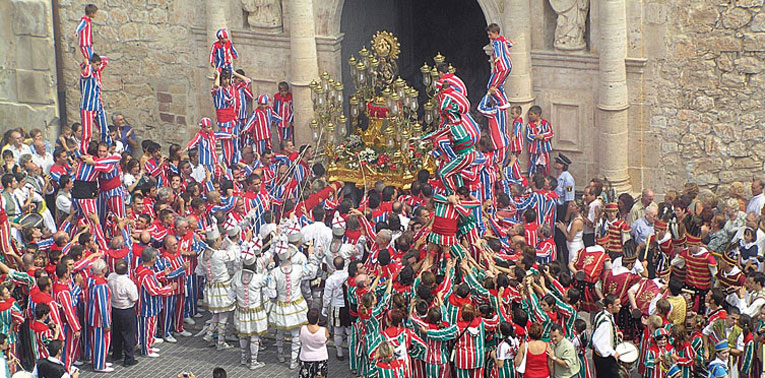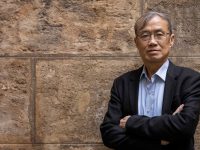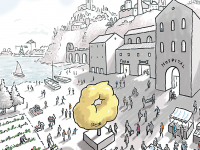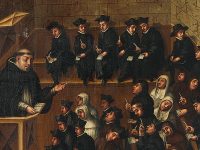
 © Antonio Ariño |
||
|
I seem to recall my first memories of the Muixeranga1 were set in the street Molí de la Vila, just where it crosses the Capella, in Algemesí. As night fell, amid a blaze of candles, a trembling tower of men rose up, reaching to the heavens. The sweet September air was filled with a strange-smelling mixture of burning wax and sweat-soaked cloth. The sound of the pipe2 and drum bestowed great solemnity upon the scene. It seemed as if the crowd expected something magical to happen when those giants at last crowned the summit. I remember watching on in astonishment, quite overwhelmed by the ritual, gripping my father’s hand –a farm labourer’s hand, huge and rough like a scouring pad–. It is a far-off recollection, a scrap of memory trapped in a spider’s web of narrow streets, nineteenth-century houses, kitchen gardens, bell ringing… a memory as hazy as –or hazier than– those first perceptions of self, utterly intuitive, a collective identity. Thus, the Muixeranga represents one piece in the puzzle of what we were, what we had been and what we wanted to be, and perhaps still are. However, at that time –I am speaking about the late seventies– the Muixeranga had not yet acquired the renowned status it enjoys today. It was quite unknown beyond the city’s boundaries. What had been a traditional dance, practised throughout the country, was little more than a rare fossil of popular culture, the exclusive property of a farming village in the Ribera del Júcar, traditionalist to the very core. As if this were not enough, for decades the local inhabitants, farmers or builders had earned a bad name in the neighbourhood. According to the most malicious gossip, most of them went to the procession in exchange for money, which was inevitably spent in the taverns at the bar. Indeed, the termmuixeranguer was even commonly used with clearly offensive connotations. Franco’s national-catholic consistory strove to preserve the entire festival celebrating Mare de Déu de la Salut , and the Muixeranga along with it, but they did not quite manage it. In fact the guilds were the real driving force behind this popular event, and they died out in the context of change. Some of the dances were recovered, whimsical tweaking to boot, but the Muixeranga began to wane desperately and by 1973 it had almost disappeared altogether. The writer Martí Domínguez i Barberà, the town’s Mayor Manuel Rico, the festival organiser in the Capella neighbourhood, Vicent Raga, and the priest Vicent Castell Maiques, with the support of the students’ association Associació d’Antics Alumnes dels Maristes, were responsible for re-launching it under the guidance of Tomàs Pla. Just five years after the village had witnessed this popular festival’s revival, Eloi Miralles –a pharmacist and member of the Colla de Castellers de Vilafranca del Penedès– came onto the scene, and he moved heaven and earth for the muixeranguers to visit the Penedès capital. Thus, on August 31, 1978, the Muixeranga rose up in Villafranca’s main square, banishing forever that lack of visibility which might have proved fatal. |
«The Muixeranga –reappraised– enjoys excellent health, grows in membership, is copied in other Valencian towns and sails on a safe course amid the rough seas of globalization» |
|
 © Mario Rabasco |
||
|
The enthusiastic and progressive nationalistic trends of the eighties consolidated the Muixeranga as one of the most cherished icons of Valencian identity. Indeed, the writer Joan Fuster was to suggest adopting its tune as an alternative anthem to the Anthem, an idea fervently defended by the social conservative political wing. In fact the tune certainly competed, and still competes, with the zarzuela-like Valencian hymn «per ofrenar noves glòries a Espanya». So, things have changed a great deal. In 2011 the festival earned the World Heritage title, and Muixeranga –one of its most unique features– now has two groups. Even women take part, something unthinkable until recently and representing a milestone –it must be said– not easily achieved. Anyhow, normality now reigns over any desire for heated political debate. Indeed, the Muixeranga has defeated those who sought in the past, and perhaps still seek, to absurdly and perversely attribute to it evil values, endeavouring to convert it, like so many other elements of any country’s identity –its own language–, into an instrument of goodness knows what dark conspiracies. Nowadays, the Muixeranga –reappraised– enjoys excellent health, grows in membership, is copied in other Valencian towns, is met with enthusiasm and without complexes in the casteller, Catalan world, where it is almost venerated and –at last– sails on a safe course amid the rough seas of globalization, dreaded multiculturalism, set upon making a long journey. Notes: 1. A performance where people stand on each other’s shoulders to form human castles (go back to the text). 2. “Pipe” refers to the dolçaina, a double-reed oboe-like instrument (go back to the text) Francesc Viadel. Journalist (Barcelona). |
||





